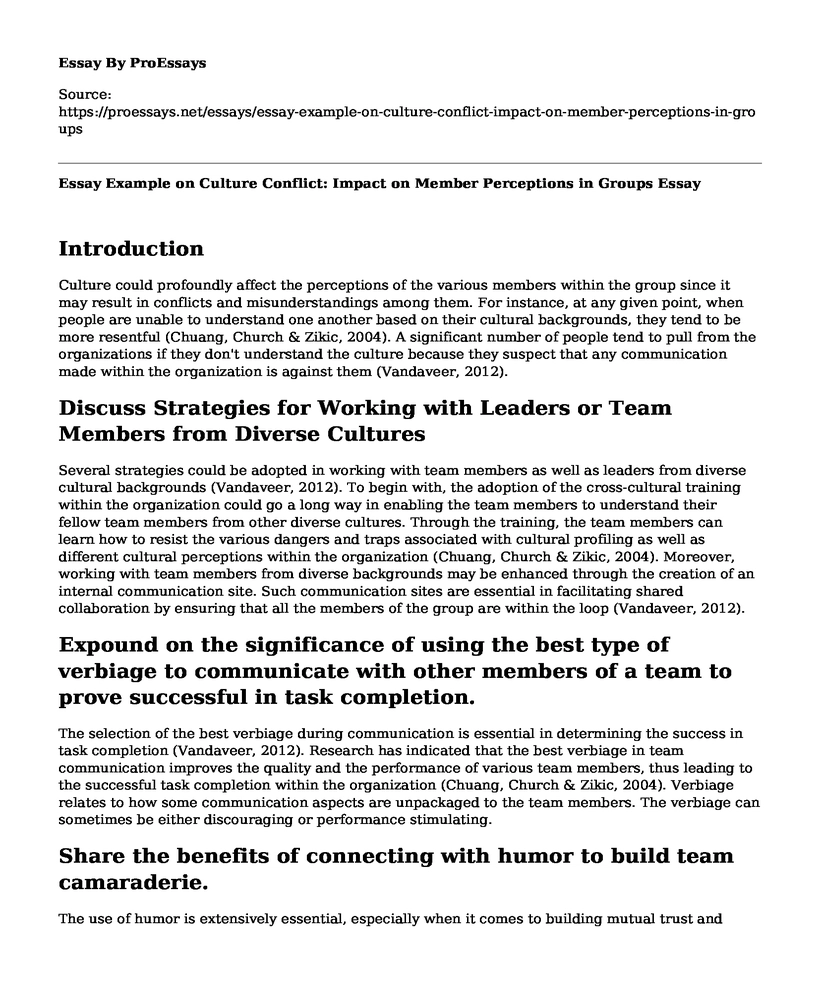Introduction
Culture could profoundly affect the perceptions of the various members within the group since it may result in conflicts and misunderstandings among them. For instance, at any given point, when people are unable to understand one another based on their cultural backgrounds, they tend to be more resentful (Chuang, Church & Zikic, 2004). A significant number of people tend to pull from the organizations if they don't understand the culture because they suspect that any communication made within the organization is against them (Vandaveer, 2012).
Discuss Strategies for Working with Leaders or Team Members from Diverse Cultures
Several strategies could be adopted in working with team members as well as leaders from diverse cultural backgrounds (Vandaveer, 2012). To begin with, the adoption of the cross-cultural training within the organization could go a long way in enabling the team members to understand their fellow team members from other diverse cultures. Through the training, the team members can learn how to resist the various dangers and traps associated with cultural profiling as well as different cultural perceptions within the organization (Chuang, Church & Zikic, 2004). Moreover, working with team members from diverse backgrounds may be enhanced through the creation of an internal communication site. Such communication sites are essential in facilitating shared collaboration by ensuring that all the members of the group are within the loop (Vandaveer, 2012).
Expound on the significance of using the best type of verbiage to communicate with other members of a team to prove successful in task completion.
The selection of the best verbiage during communication is essential in determining the success in task completion (Vandaveer, 2012). Research has indicated that the best verbiage in team communication improves the quality and the performance of various team members, thus leading to the successful task completion within the organization (Chuang, Church & Zikic, 2004). Verbiage relates to how some communication aspects are unpackaged to the team members. The verbiage can sometimes be either discouraging or performance stimulating.
Share the benefits of connecting with humor to build team camaraderie.
The use of humor is extensively essential, especially when it comes to building mutual trust and friendship in the workplace- a term referred to as camaraderie (Vandaveer, 2012). For instance, the humor in the workplace reduces stress among the team members, thus increasing their productivity. Again the humor in the organization helps in motivating the workers, thereby leading to a more positive culture within the organization (Chuang, Church & Zikic, 2004).
Explain how personality traits, social factors, and styles of leadership can affect the competence and loyalty of a team member.
Social factors, personality traits, as well as leadership always have a significant impact on the loyalty and competence of the team member. For instance, personality traits influence the thoughts, feelings, and actions of workers in every situation. For example, extroverts should always give a chance for the introverts also to feel valued and give their inputs, thus improving loyalty and competence (Chuang, Church & Zikic, 2004). Again the leadership styles may sometimes be inappropriate, thus reducing the output of the workers. For instance, dry and over-aggressive leaders often tend to reduce the morale, loyalty, and competence of the team members (Vandaveer, 2012).
Determine the different career options an employee might consider when having trouble working with a cohort or leader of a department.
A good and productive employee working in a wrong position could harm both business success and the particular employee (Chuang, Church & Zikic, 2004). For instance, the employees that may experience trouble in working with a leader or cohort of a department could often resort to some other career options either within the organization or outside the organization (Vandaveer, 2012).
References
Chuang, Y. T., Church, R., & Zikic, J. (2004). Organizational culture, group diversity, and intragroup conflict. Team Performance Management: An International Journal. Retrieved from https://doi.org/10.1108/13527590410527568
Vandaveer, V. V. (2012). Dyadic team development across cultures: A case study. Consulting Psychology Journal: Practice and Research, 64(4), 279. Retrieved from https://psycnet.apa.org/doi/10.1037/a0031652
Cite this page
Essay Example on Culture Conflict: Impact on Member Perceptions in Groups. (2023, Apr 24). Retrieved from https://proessays.net/essays/essay-example-on-culture-conflict-impact-on-member-perceptions-in-groups
If you are the original author of this essay and no longer wish to have it published on the ProEssays website, please click below to request its removal:
- Advanced Professional Practice Paper Example
- Specificity of Addictions, Employee Motivation and Workshop Diversity Articles Analysis
- Teachers Pay Essay Example
- Occupational Health and Safety Administration Cites Missouri Plumbing Company - Essay Sample
- Essay Example on Cultural Competency: A Priceless Asset for Understanding Others
- My Journey to Becoming a Licensed Professional Counselor in California - Free Essay
- Corporate Compliance: A Necessity for Healthcare Leaders - Free Paper Sample







